My first camping trip was a lesson in preparedness. I’ll never forget waking up in the middle of the night to a leaky tent—water dripping onto my sleeping bag, turning what should have been a peaceful retreat into a soggy mess. That experience taught me one thing: the right camping gear can make or break your adventure.
Whether you’re planning a weekend getaway or a longer expedition, having reliable equipment transforms surviving in the great outdoors into thriving. From sturdy shelters like the Ikos tent to cozy sleep systems and practical campsite tools, every piece plays a vital role. Balancing budget with quality ensures you’re prepared without overspending.
There’s something magical about disconnecting from the noise of daily life and reconnecting with nature. With the right gear, you can focus on the joy of the experience rather than worrying about the basics. Let’s dive into the essentials that will set you up for success on your next outdoor adventure.
Key Takeaways
- Proper gear turns camping from survival to enjoyment.
- Invest in reliable shelter, like the Ikos tent, for comfort.
- Sleep systems are crucial for restful nights outdoors.
- Campsite tools enhance convenience and safety.
- Balance budget and quality for long-term value.
- Disconnecting in nature is easier with the right equipment.
Introduction to Camping Gear for Beginners
Starting your outdoor journey can feel overwhelming, but the right gear makes all the difference. Whether you’re pitching a tent or opting for a cabin, your choice of equipment shapes your experience. According to KOA statistics, 45% of campers are now drawn to glamping, blending comfort with nature. However, traditional tent camping remains a popular choice for its simplicity and connection to the outdoors.
New campers often face “analysis paralysis” when selecting gear. With so many options, it’s easy to feel stuck. I remember my first camping trip in Joshua Tree—I forgot the ground stakes, and my tent nearly flew away! That lesson taught me the importance of preparation and the right tools.
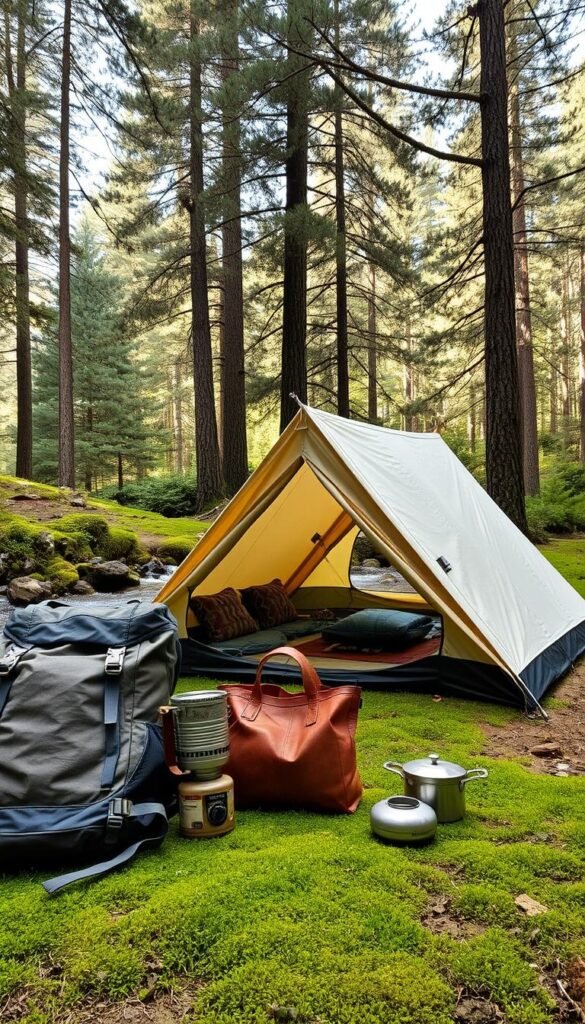
Your gear isn’t just equipment; it’s the foundation of memories. A sturdy 3-season tent, for example, offers versatility for most weather conditions. It’s not about having the most expensive items but choosing what works best for your needs.
To simplify the process, I recommend the Explorer’s Checklist approach. This method breaks down gear selection into manageable steps, ensuring you’re ready for your outdoor experience. Here’s a quick comparison to help you decide between tent camping and other options:
| Option | Pros | Cons |
|---|---|---|
| Tent Camping | Affordable, immersive, portable | Requires setup, weather-dependent |
| Cabins | Comfortable, weatherproof | Less immersive, higher cost |
| RVs | Mobile, equipped with amenities | Expensive, less eco-friendly |
No matter your choice, the right gear ensures your trip is memorable for all the right reasons. Let’s dive deeper into the essentials that will set you up for success.
Essential Camping Gear for Beginners
Camping gear is the backbone of any successful outdoor adventure. From shelter to sleep systems, every piece plays a critical role in ensuring comfort and safety. When I first camped in Yosemite, I learned the hard way that cutting corners on equipment can lead to sleepless nights and soggy mornings.
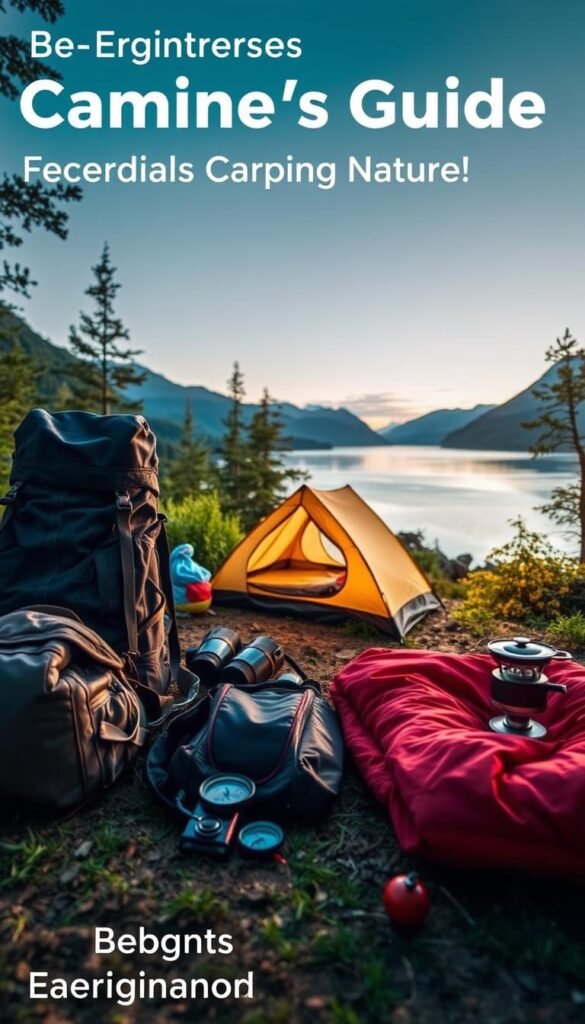
Tent: Your Home Away From Home
Choosing the right tent is the first step to a great camping trip. Dome tents, like the REI Co-op Half Dome SL, are lightweight and easy to set up, making them ideal for beginners. Cabin tents, on the other hand, offer more headroom and space but can be bulkier to carry.
During my Joshua Tree adventure, I realized the importance of a sturdy tent. A cheap department store option might save money upfront, but it won’t withstand wind or rain. Invest in a reliable shelter like the Ikos Lightweight Tent for long-term value.
Sleeping Bag: Stay Warm and Cozy
Your sleeping bag is your lifeline for a restful night. Temperature ratings are crucial—my Yosemite trip taught me to subtract 10°F from forecast lows for better insulation. A three-season bag is versatile enough for most conditions.
I once made the mistake of using a budget sleeping bag from Walmart. It left me shivering all night. Instead, opt for a quality bag that balances warmth and weight.
Sleeping Pad: The Unsung Hero
A sleeping pad is more than just cushioning—it’s insulation. The R-value measures its ability to retain heat. For example, the Therm-a-Rest Comfort Deluxe Self-Inflating Pad has an R-value of 3.5, making it perfect for three-season use.
During a backyard trial, I tested my sleep system—tent, sleeping bag, and pad. This “Triangle of Comfort” ensures a cozy night, even on uneven terrain.
| Gear | Key Features | Recommendation |
|---|---|---|
| Tent | Lightweight, weather-resistant | Ikos Lightweight Tent |
| Sleeping Bag | Temperature-rated, three-season | REI Co-op Magma 15 |
| Sleeping Pad | High R-value, self-inflating | Therm-a-Rest Comfort Deluxe |
Your sleep system is the foundation of a great camping experience. For more tips on optimizing your setup, check out this guide on sleep system essentials.
Choosing the Right Tent for Your Camping Trip
Your tent is more than just shelter—it’s your home base in the wilderness. A well-chosen tent ensures comfort and safety, no matter the weather conditions. Whether it’s your first camping trip or your fiftieth, the right tent can elevate your camping experience.
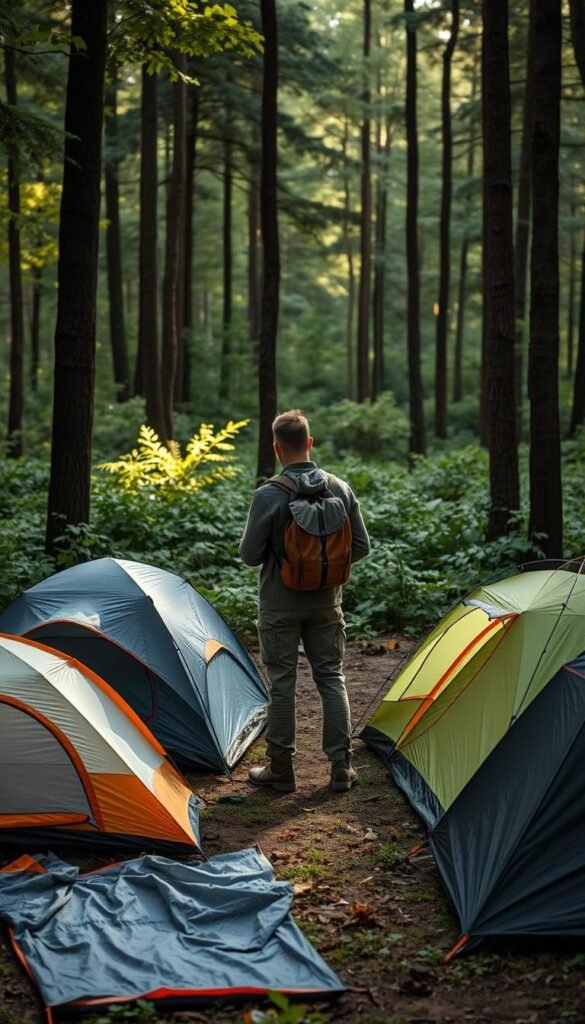
Size and Capacity
When choosing right tent size, consider both space and practicality. A Coleman 4-person tent offers ample room for a family, while the MSR Hubba Hubba is ideal for two. Remember, a tent’s capacity often feels smaller once gear is inside. Always opt for a size larger than your group count for comfort.
Seasonality and Weather Resistance
Seasonality is crucial. A 4-season tent, like the Big Agnes Copper Spur, is built for harsh conditions. For milder climates, a 3-season tent suffices. Look for features like waterproof materials and reinforced seams to handle rain and wind. A footprint adds extra protection against moisture and wear.
Ease of Setup and Portability
Setup time matters. Color-coded pole systems, like those in Sierra Designs tents, simplify pitching. Practice in your backyard to master the process. Portability is another factor—lightweight tents are easier to carry but may sacrifice durability. Balance weight with your pack capacity, especially for long hikes.
| Feature | Coleman 4-Person | MSR Hubba Hubba |
|---|---|---|
| Capacity | 4 people | 2 people |
| Weight | 9.8 lbs | 3.5 lbs |
| Setup Time | 10 minutes | 5 minutes |
| Seasonality | 3-season | 3-season |
Your tent is the cornerstone of your outdoor adventure. By considering size, seasonality, and setup, you’ll find the perfect match for your needs. Happy camping!
Sleep System: Sleeping Bags and Pads
There’s nothing worse than shivering through a cold night outdoors—trust me, I’ve been there. On a trip to the Grand Canyon, I learned the hard way that a good sleep system is non-negotiable. Your sleeping bags and pads are the foundation of restful nights, ensuring you wake up refreshed and ready for adventure.
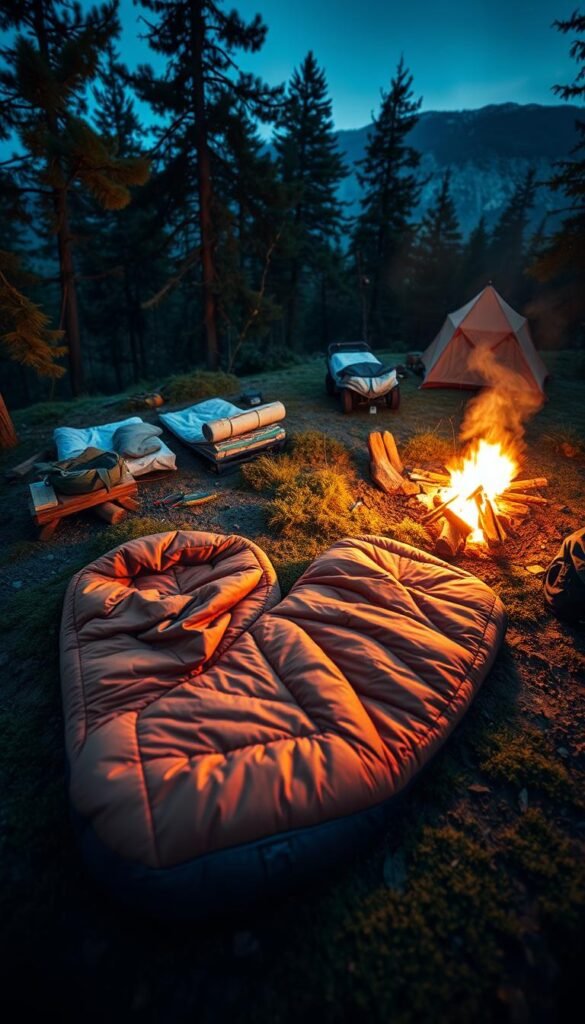
Sleeping Bag Selection
Choosing the right sleeping bags starts with understanding fill types. Down, like Patagonia’s Down Sleeping Bag, offers superior warmth-to-weight ratio and compressibility. Synthetic fills, such as those in Kelty’s Cosmic 20, are more affordable and perform better in wet conditions.
The EN Rating system is another key factor. It standardizes temperature ratings, so you know exactly what to expect. For example, the Marmot Trestles 15 is rated for 15°F, making it a reliable choice for colder temperatures.
Layering can also enhance your setup. I often pair my REI Co-op Magma 15 with a Sea to Summit Thermolite liner for extra warmth. This combo saved me during a chilly night in the Rockies.
Sleeping Pads Types and Comfort
Sleeping pads are more than just cushioning—they’re essential for insulation. The R-value measures their ability to retain heat. For example, the Therm-a-Rest NeoAir XTherm has an R-value of 6.9, making it ideal for winter camping.
On the other hand, the Nemo Switchback is a lightweight foam pad with an R-value of 2.0, perfect for summer trips. I once used a budget pad in the Grand Canyon and woke up with “Cold Butt Syndrome”—a lesson in the importance of proper comfort.
| Type | Example | Key Features |
|---|---|---|
| Down Sleeping Bag | Patagonia Down Sleeping Bag | Lightweight, compressible, warm |
| Synthetic Sleeping Bag | Kelty Cosmic 20 | Affordable, performs well in wet conditions |
| Inflatable Pad | Therm-a-Rest NeoAir XTherm | High R-value, lightweight |
| Foam Pad | Nemo Switchback | Durable, affordable, easy to use |
Your sleep system is your ticket to restful nights under the stars. By choosing the right sleeping bags and pads, you’ll stay warm, comfortable, and ready for whatever the wilderness throws your way.
Campsite Essentials: Ground Cover and Tarps
Setting up a campsite feels like building a second home in the wilderness. From protecting your tent floor to creating extra shelter, ground covers and tarps are essential for comfort and durability. I learned this the hard way during a rainy weekend in the Smoky Mountains—without proper protection, my tent floor turned into a soggy mess.
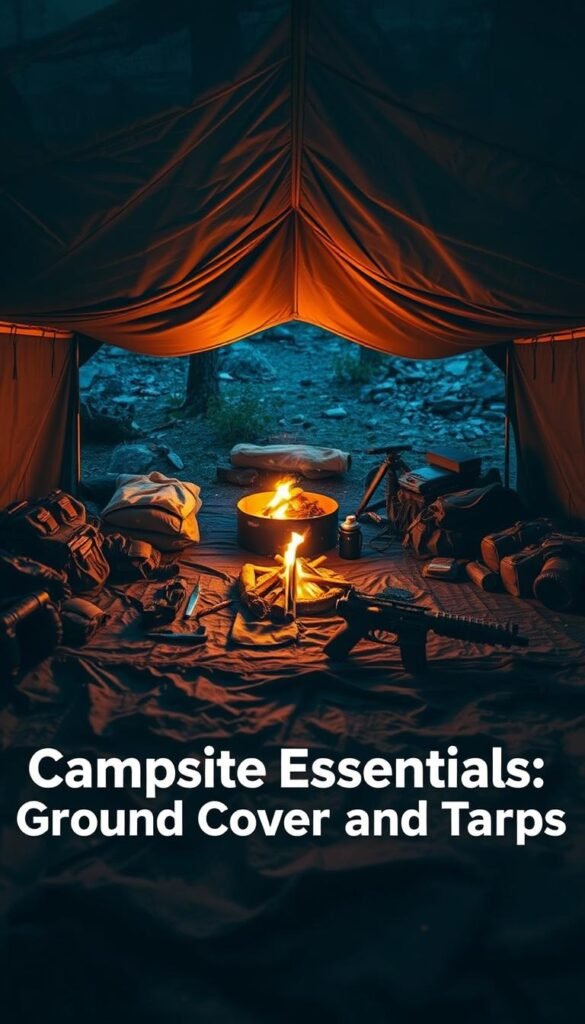
Ground Cover and Footprint
A footprint is your tent’s first line of defense against moisture and wear. You can choose between DIY options, like Tyvek, or branded solutions, such as the MSR Groundhog. Tyvek is lightweight and affordable, but MSR’s custom-fit footprints offer precise protection. During a trip to Yellowstone, I used a Tyvek sheet and reinforced it with duct tape—it worked, but a branded footprint would’ve been easier.
Polyethylene footprints are another great option. They’re durable and waterproof, making them ideal for harsh weather conditions. Whether you go DIY or branded, a footprint ensures your tent stays dry and intact.
Tarps and Shelter Solutions
Tarps are versatile tools for any campsite. The Kelty Noah’s Tarp is a favorite for its durability and multiple configurations. You can set it up as an A-frame for quick shelter or a dining fly for group gatherings. I once used trekking poles as tarp supports during a sudden downpour—it was a MacGyver moment that saved the day.
Moisture management is key. The ENO ProFly tarp is designed to shed water efficiently, keeping your gear dry. Pair it with Nite Ize gear for secure knot-tying—I recommend the Bowline knot for quick setup and stability.
| Option | Pros | Cons |
|---|---|---|
| Tyvek Footprint | Lightweight, affordable | Requires DIY adjustments |
| MSR Groundhog | Custom-fit, durable | Higher cost |
| Kelty Noah’s Tarp | Versatile, weather-resistant | Bulkier to carry |
| ENO ProFly | Efficient moisture management | Requires practice to set up |
With the right ground cover and tarp setup, your campsite becomes a haven of comfort and protection. Whether you’re braving rain or wind, these essentials ensure you’re ready for anything nature throws your way.
Campsite Tools and Accessories
Campsite tools are the unsung heroes of any outdoor adventure. They transform a simple setup into a functional, comfortable space. Whether it’s lighting up the night or maintaining your gear, the right accessories make all the difference. I’ve learned this firsthand during my trips—like the time a reliable headlamp saved me from stumbling in the dark.
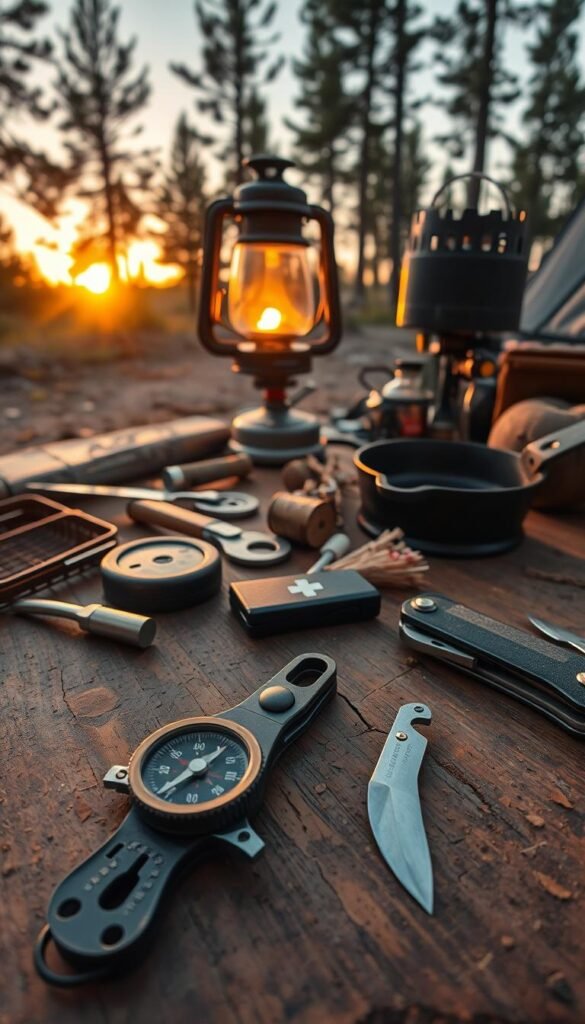
Lighting and Illumination
Good lighting is essential for safety and convenience. The Black Diamond Spot headlamp is a favorite for its brightness and lightweight design. It’s perfect for late-night hikes or cooking under the stars. On the other hand, the Goal Zero lantern offers ambient light for group gatherings. It’s a must-have for creating a cozy atmosphere at your campsite.
During a trip to the Rockies, I relied on both. The headlamp helped me navigate trails, while the lantern turned our campsite into a warm, inviting space. Lighting tiers matter—choose based on your needs.
Cutting Tools and Gear Maintenance
Cutting tools are versatile and indispensable. The Leatherman Signal multi-tool is a game-changer. It combines a knife, pliers, and even a fire starter. I’ve used it for everything from gear repairs to preparing meals. The Gerber Center-Drive is another solid option, especially for heavy-duty tasks.
Maintaining your tools is just as important. I once sharpened my knife with the Fallkniven DC4 during a trail repair. It’s compact and effective, ensuring your tools stay in top shape. A well-maintained kit is key to the best camping experience.
Don’t forget a first aid kit. The Adventure Medical Kits are comprehensive and easy to carry. They include essentials like bandages, antiseptics, and even a CAT tourniquet. I’ve patched up minor injuries on the trail, proving that an aid kit is a lifesaver.
Finally, tools like Tenacious Tape and cordage are invaluable for quick fixes. During a windy night in Utah, I used them to secure my tent. These small items can make a big difference in ensuring your trip goes smoothly.
Cooking Equipment Basics for Camping
Nothing beats the aroma of freshly cooked meals under the open sky—camping food just hits different. Whether you’re whipping up a hearty breakfast or a quick dinner, the right cooking gear makes all the difference. From portable stoves to durable cookware, every piece plays a role in creating memorable meals.
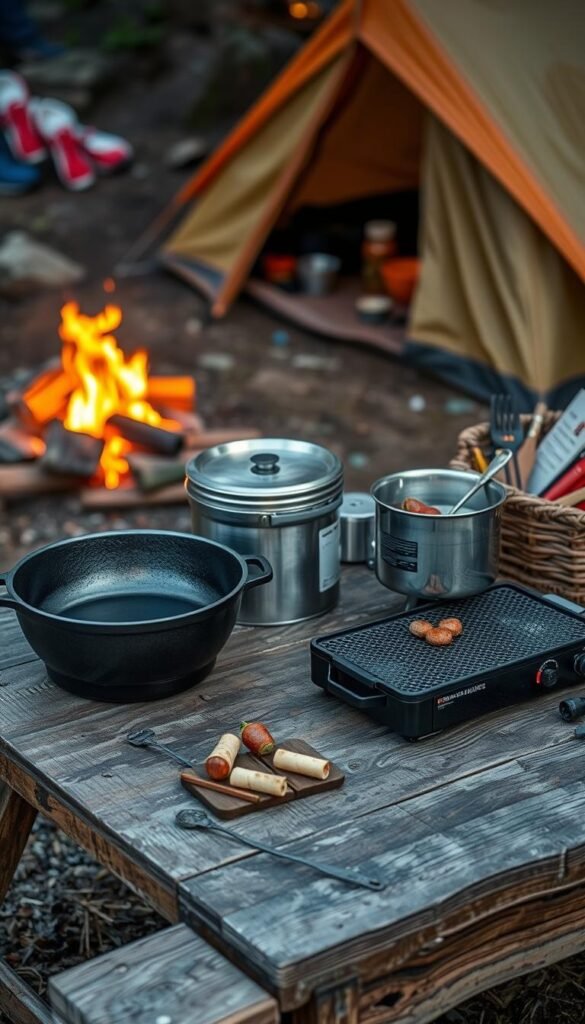
Portable Stove
Your stove is the heart of your camp kitchen. Canister stoves, like the Jetboil Flash, are lightweight and perfect for quick boils. Liquid fuel stoves, such as the MSR WhisperLite, excel in colder climates and offer versatility. I’ve used both during my trips—the Jetboil for fast coffee and the WhisperLite for simmering stews.
For beginners, the Coleman Classic Propane Stove is a budget-friendly option. It’s reliable and easy to use, making it ideal for family trips. Pair it with a windscreen for better efficiency in windy conditions.
Cookware Set
Choosing the right cookware depends on your needs. Titanium sets, like Snow Peak’s Trek 1400, are lightweight and durable. Aluminum options, such as the Stanley Adventure Base Camp, are more affordable and still perform well. I’ve cooked everything from pancakes to pasta in my GSI Outdoors Pinnacle set—it’s a versatile choice for any camper.
Don’t forget utensils! A silicone spatula and a sturdy knife are essentials. For one-pot meals, the Sea to Summit X-Pot is a game-changer. It’s collapsible, easy to clean, and perfect for minimalist setups.
Cooler
Keeping food fresh is crucial. The Yeti Tundra is known for its ice retention, lasting up to 7 days in ideal conditions. The RTIC 65 is a more affordable alternative, offering similar performance. During a weekend trip, I tested both—the Yeti kept my drinks colder, but the RTIC held its own.
For shorter trips, the Igloo MaxCold is a great budget option. It’s lightweight and easy to carry, making it ideal for car camping. Always pre-chill your cooler and use block ice for longer-lasting cold.
| Feature | Jetboil Flash | Coleman Classic |
|---|---|---|
| Weight | 13.1 oz | 11 lbs |
| Fuel Type | Canister | Propane |
| Best For | Backpacking | Family Camping |
Organizing your camp kitchen is just as important. Front Runner boxes keep everything tidy, while a folding table creates a functional workspace. For more tips on mastering camp cooking, check out this beginner’s guide.
Conclusion
Camping isn’t just about the gear—it’s about the stories you create along the way. Embrace the “Less Gear, More Experience” philosophy. Focus on what truly matters: the connection to the great outdoors and the memories you’ll cherish forever.
Ready to take your adventures further? Consider upgrading to backpacking with reliable Osprey packs. They’re designed to carry your essentials while keeping you comfortable on the trail. Remember, your gear should serve memories, not master them.
Looking for a place to start? Check out local state parks—52% of campers stay within 100 miles of home. They’re perfect for honing your skills and enjoying the camping experience without traveling far.
As you grow more confident, explore advanced topics like bear canisters and GPS navigation. The wilderness is vast, and there’s always more to discover. Happy trails!

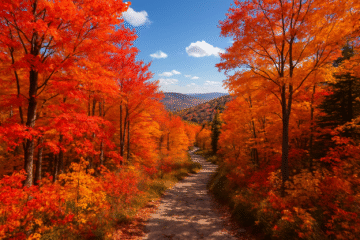
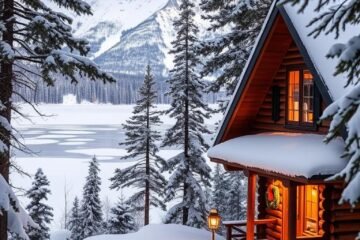
0 Comments